The Kerr family acquired the lands in the sixteenth century; the Kerrs themselves are an old Borders family, recorded in the Lowlands from the 12th century. Monteviot itself is an ancient site, and Dere Street, the Roman road from York to Newstead at Melrose (Trimontium), runs through the park. The present house of Monteviot began as an early-eighteenth century lodge built by the 1st Marquis of Lothian. In the nineteenth century Monteviot, was greatly admired and was developed into the principal seat of the Marquises of Lothian. Ambitious designs from Edward Blore were commissioned for a Jacobean-style mansion at Monteviot in 1832 but never completed, leaving the modest Georgian house and Blore’s elaborate Jacobean-inspired office wing side by side. In 1961 the interior was re-planned to the design of Schomberg Scott.
Book a guided tour >
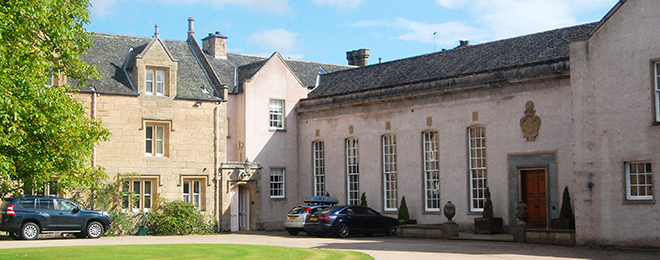
The visitor arriving at Monteviot does not immediately see the Georgian house which faces south towards the river, but is greeted by Schomberg Scott’s new frontage of 1962-3 and Blore’s gabled, dressed sandstone east wing of 1830-2 with, at its north end, the 9th Marquis’s picturesque water tower of 1877.
Schomberg Scott’s work is pink-harled with stone trimmings, tall sash windows and carved heraldry devised by Don Pottinger. The stone plaques over the windows, from east to west, are carved with family ciphers and symbols: AN (for Antonella Newland, Marchioness of Lothian); a stag’s head (one of the Kerr crests); LL and a coronet (entwined Ls for Lord and Lady Lothian); a unicorn’s head (a unicorn is the sinister supporter of the Lothian arms); PK (for Peter Kerr, Marquis of Lothian); the full quartered Lothian arms (Kerr of Lothian and Kerr of Jedburgh) topped with the sun in splendour crest of the family (over the main entrance); and to the right, the Lothian knot.
Over the side entrance in the west wing (added in 1978) is a weathered marriage stone of 1558 (the original of which is near the tennis court) and, on the carved keystone, a linked cipher for Michael and Jane Ancram. The two large stone urns flanking the main entrance are early Eighteenth Century and come from Ancrum House.
The pitched slate roof over the hall is a recent addition which greatly improves the appearance of the house, as well as being of practical benefit.
The Great Hall
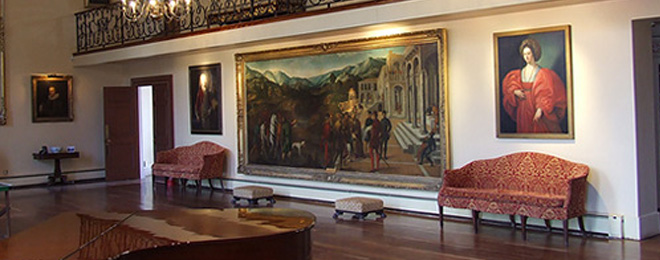
The major addition to the house in 1962-3 was this large hall, which was conceived of as a general place of assembly and focus for the house, and as a gallery for the display of the larger family pictures from Newbattle Abbey.
It is entirely a Schomberg Scott design with a Scottish wagon ceiling (inspired by Falkland Palace), the gallery and stairs having a wrought iron balustrade made in Edinburgh. Schomberg Scott also designed some of the furniture, including the tables between the windows and the upholstered benches in the gallery. The floor is of African mahogany, a hardwood much used by architects in the 1960s.
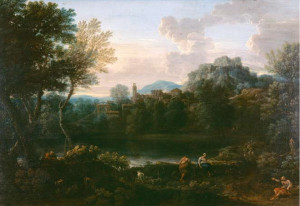
The room was designed especially for the full-length equestrian portrait of Charles I by Van Dyck which dominates the east wall. This is a contemporary version of that painted for the gallery at St. James's, which is now at Buckingham Palace, and was probably a gift from the king to his old tutor Robert 1st Earl of Ancram. It is flanked by portraits of the Earl of Ancram himself by John Eyke (1618), and his second wife Lady Anne Stanley, daughter of the 6th Earl of Derby.
Much of the lower part of the south wall is filled with a long frieze-like Venetian painting of the Parable of the Prodigal Son by Bonifazio Pitati. This was acquired by the 8th Marquis from Alton Towers in Staffordshire, seat of the Earls of Shrewsbury in 1857. It is flanked by portraits of an Eighteenth Century naval officer, possibly Captain Michael Kerr, by Michael Dahl and a portrait of Joan Queen of Naples, after a lost original by Bernardino Licinio.
Beyond, hanging over the Regency card table, is a fine imaginary classical landscape by John Wootton, which shows the strong influence of Claud Lorraine on English Eighteenth Century art. Wootton is better known for his horse paintings, but this shows his talents as a landscape artist.
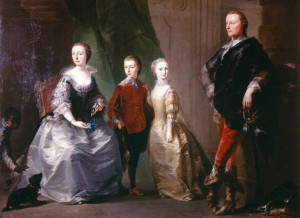
The large portrait hanging over the staircase is of the 4th Marquis of Lothian (the Hanoverian cavalry officer) and his family by Joseph Anton Adolf. Below it, at the foot of the stairs, is a self-portrait of Sir John Medina, the distinguished Scottish late Seventeenth Century painter. Along the gallery are hung several smaller Seventeenth Century portraits.
Between the windows on the north side of the room is a portrait by Francis Cotes of John Hobart, Earl of Buckinghamshire, from whom was inherited the silver wine cooler. He had a distinguished political career, and as well as being ambassador to Catherine the Great, he was also Viceroy of Ireland. Next along is a portrait of Sir Thomas Overbury (who was probably murdered by the Countess of Somerset). At the east end is a portrait of the 3rd Marquis and his younger brother Lord Robert Kerr as boys, by William Aikman. As part of their education they went on an extended Grand Tour of Europe and the 3rd Marquis began the collection of Continental paintings which continued to be added to in the Nineteenth Century. There are also portraits of Robert 1st Marquis of Lothian and his wife Lady Jane Campbell, the latter attributed to David Scougall.

The best piece of furniture in the room is the Seventeenth Century cabinet on stand, between the windows, decorated with seaweed marquetry. On the first landing of the main staircase there is a small German cabinet with fine architectural marquetry which contains a collection of Grand Tour moulds of antique (Roman) gems. Opening from the north east corner of the hall, a passage leads to two private rooms contrived by Schomberg Scott between the Georgian house and the Blore wing.
The Square Hall
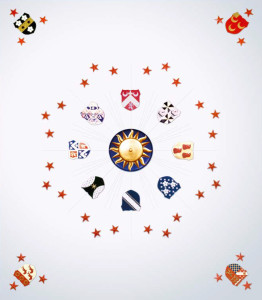
This immediately introduces the interior work of Schomberg Scott who, unusually for an architect of the 1960s, himself designed many of the details including some of the furnishings and the heraldic wallpaper in here (recently renewed in pale blue). The floor is of a polished blue Westmoreland slate, and the wrought iron balustrade of the gallery is a fine example of modern Scottish craftsmanship carried out to Schomberg Scott's design. Schomberg Scott also designed the heraldic plaster ceiling which has the Sun in splendour and the Kerr stars as well as painted shields showing the arms of successive wives of the Marquises of Lothian.
Around the central sun:
CAMPELL of ARGYLL.
i. Jane, daughter of Archibald. Marquis of Argyll. Wife of Robert 1st Marquis of Lothian.
ii. Jane, daughter of Archibald, 9th Earl of Argyll. Wife of 2nd Marquis of Lothian.
NICHOLSON of KEMNAY. Margaret daughter of Sir Thomas Nicholson of Kemnay. Wife of William, 3rd Marquis of Lothian.
D'ARCY of HOLDERNESS. Caroline, daughter of Robert, Earl of Holderness. Wife of William, 4th Marquis of Lothian.
FORTESCUE of DROMISKEN. Elizabeth, daughter of Chichester Fortescue, Esq. of Dromisken. Wife of William, 5th Marquis of Lothian.
HOBART of BUCKINGHAMSHIRE. Henrietta, daughter of John, 2nd Earl of Buckinghamshire. Wife of William, 6th Marquis of Lothian.
TALBOT of SHREWSBURY.
i. Cecil, daughter of Charles, 2nd Earl Talbot. Wife of John, 7th Marquis of Lothian.
ii. Constance, daughter of Henry, 18th Earl of Shrewsbury. Wife of William, 8th Marquis of Lothian.
SCOTT of BUCCLEUCH. Victoria, daughter of Walter Francis, 5th Duke of Buccleuch. Wife of Schomberg, 9th Marquis of Lothian.
NEWLAND. Antonella, daughter of Maj. General Sir Foster Reuss Newland. Wife of Peter, 12th Marquis of Lothian.
In the four corners:
HOWARD of NORFOLK.
i. Anne, daughter of Henry, 14th Duke of Norfolk. Mother of Philip, 11th Marquis of Lothian (d. unmarried).
ii. Jane, daughter of 16th Duke of Norfolk. Wife of Michael, 13th Marquis of Lothian.
COKE of MELBOURNE, Derbyshire.
LAMB of MELBOURNE, Derbyshire.
COWPER of MELBOURNE, Derbyshire.
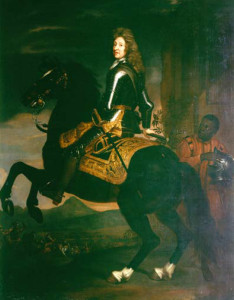
This heraldry acts as an introduction to the post-union history of the Lothian family which Monteviot encapsulates, whereas Ferniehirst Castle to the south of Jedburgh represents the older, Scottish history of the Kerrs. The 1st Marquis was a supporter of William III and also of the Act of Union, and successive generations have intermarried with prominent English families, notably the Norfolks, premier Dukes, and the Shrewsburys, premier Earls of England, and heiresses who brought English houses and estates: Blickling in Norfolk (now National Trust) and Melbourne, Derbyshire, which is now the home of Lord Lothian's brother, Lord Ralph Kerr.
This room is also an introduction to the Lothian picture collection which, as well as comprising a long series of family portraits, is also rich in Dutch and Italian Old Masters collected in the Eighteenth and Nineteenth Centuries and formerly at Newbattle Abbey, near Dalkeith.
On the east wall is a large equestrian portrait by Godfrey Kneller of the Duke of Schomberg, William III's General at the Battle of the Boyne and great-grandfather of the wife of the 4th Marquis of Lothian. Above the gallery is a portrait of Miss Lemon, reputed mistress of and described as 'after' Sir Anthony van Dyck. On the west wall is a fine portrait by George Knapton of the 3rd Marquis (1690 – 1767) in Thistle Robes. He sat at Westminster as a Scottish Representative Peer, and was Lord High Commissioner to the Church of Scotland on three occasions. Below is a family group by David Morier of the 4th Marquis (1710 – 1775) and his wife Caroline, daughter of the Earl of Holderness. The 4th Marquis pursued a military career and fought at Culloden, commanding 'Kerr's Horse', later the 11th Dragoons, a force which the family raised in the Lowlands.
The Old Masters in here include: Shepherd playing his Pipes by Jacob Backer and a portrait of a Young Girl as a Shepherdess 'after Paulus Moreelse,' and landscapes by Van Huchtenberg and Jan Breughal flanking the Hunter portrait on the south wall.
The four silver wall sconces were designed by Schomberg Scott after a Seventeenth Century original. The fine japanned cabinet on stand dates from the late Seventeenth Century.
The Victorian Newbattle Table has a marquetry top composed of all the wood grown on the estate there.
Photographs in the Square Hall show among others the present Marquis of Lothian with former President Bush, former US Secretary of State Condoleeza Rice and President Mubarak of Egypt.
The Compass Room
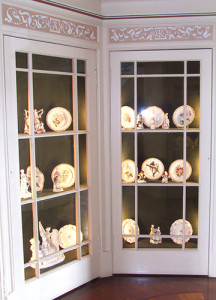
The name is a joke on the part of Schomberg Scott and alludes to the frequent complaint, before remodelling this part of the house, that it was impossible to find your way through the maze of Victorian additions. The hardwood floor is inlaid with a marquetry compass. The octagonal space is lined with glazed china cupboards containing more of the Derby service as well as Sevres biscuit and coloured porcelain figures from the Derby, Hochst, Meissen and other Eighteenth Century factories. Such figures were originally intended as table decorations for dessert and the ideas evolved from sugar confectionery. The frieze is painted with the initials of the children of the 12th Marquis and Marchioness: Mary, Michael, Cecil, Clare, Elizabeth and Ralph.
The Ante Room

This irregular space continues the axis northwards from the drawing room to the Great Hall. Once part of the Library, with its shelves removed, it now is uniquely able to show intricate pictures at close quarters. On the east wall hangs a rare still life by Evert Collier dated 1695, one of the best pictures in the collection. On the south wall there is The Counting House or Money Lenders by Jan van Hemessen dated 1536. There are contemporary portraits of the present Marquis of Lothian and his wife Lady Jane Fitzalan Howard by Nicky Phillips. Also two portraits: one of Philip 11th Marquis of Lothian, a distinguished Liberal statesman who served under Milner in South Africa, was Private Secretary to Lloyd George, Secretary of State for India and finally British Ambassador to the United States at the beginning of the Second World War, sketched by the South African artists F. Footner and the other an oval sketch of Mrs. Andrew Kerr, grandmother to the present Lord Lothian.
The drawing of Lord Lothian as captain of the Oxford University Ski Team was done in 1965 by S. Rodzianko.
The Drawing Room
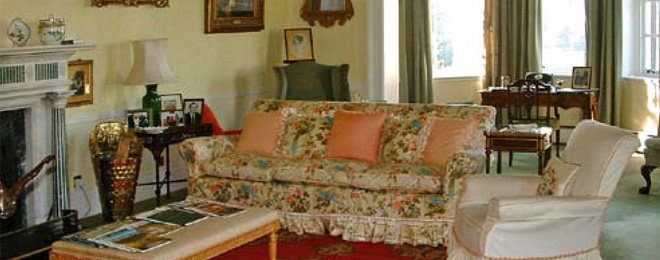
Returning through the library and the Ante Room, which is also lined with bookcases, the drawing room is reached. It fills the eastern of the twin Georgian pavilions on the south front and is a well-proportioned room with a high coved ceiling. Like the State Bedroom, it also has a canted bay with Venetian window. The fine Eighteenth Century marble chimneypiece was brought by the 12th Marquis from Crailing House, nearby.
The eighteenth and Nineteenth Century portraits in the drawing room include some of the most distinguished in the house. Starting on the West wall, to the right of the door and working round the room anti-clockwise, they are: The 4th Duke of Rutland by Sir Joshua Reynolds, Lord Newbattle, later 6th Marquis of Lothian in 'van Dyck dress' by Revd. Matthew William Peters, painted in 1778. Peters specialized in sentimental pictures of children and angels. On the fireplace wall is a very fine portrait of the 6th Marquis of Lothian in later life by Sir Henry Raeburn. The 6th Marquis was Lord Lieutenant of Midlothian and Roxburghshire, and began the improvements and tree planting that transformed Monteviot into a principal family seat in the Nineteenth Century. He caused a scandal by running off with the estranged wife of Lord Belmore and marrying her after divorce. She was the eldest daughter of the last Earl of Buckinghamshire whose possessions, including the Blickling estate in Norfolk were eventually to pass to the Lothians when they were inherited by the 7th Marquis in 1850, though in the short term Lord Buckinghamshire left them to his younger daughter, Lady Suffield, for life.
The pair of flower paintings are by Ludovic Stern and the two small oils of the 7th Marquis, who commissioned Blore to rebuild Monteviot as a large mansion, and his wife Cecil Talbot, daughter of the Earl of Shrewsbury, are by Sir Francis Grant. Over the chimneypiece is an attractive group by Benjamin West of Mrs. West and their son Raphael. The other portrait on the fireplace wall is of Elizabeth Fortescue, the wife of the 5th Marquis, by Reynolds.
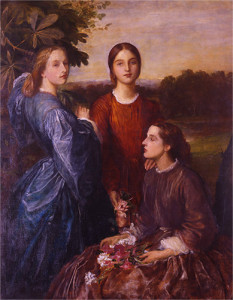
On the north wall is a characteristic portrait of a Young Man in Black by Annibale Carracci and, in the centre, a masterpiece by G. F. Watts of the three Talbot sisters, daughters of the Earl of Shrewsbury, including Constance, wife of the 8th Marquis. Next to it is a fine study of the red-bearded Marquis himself, also by Watts. A brilliant scholar who won a double first at Oxford, the 8th Marquis succumbed to a serious illness and died young. The furniture in the Drawing Room also comprises pieces of high quality. These include the two little French tables besides the sofas. That in the Louis XVI style nearer the window has a top with a square Sevres plaque which forms a reading stand, and is stamped by Edward Baldock, the famous furniture broker who supplied much at Abbotsford for Walter Scott; that nearer the door has still-life marquetry and is stamped by J.-L. Faizelot-Delorme. There is also a fine large Louis XV Kingwood writing table by Adrien Fleury under the Watts portrait, and flanking the chimneypiece a pair of Chippendale style mahogany tea tables. In the glazed cupboard is a part of a Derby botanical dessert service brilliantly painted with individual flowers by William Pegg, a Quaker and talented botanical artist much used by the Derby factory. Under the Reynolds of Elizabeth Fortescue is an ivory inlaid Renaissance coffer dated 1565 on a stand, now used to store CDs, for, like all the main apartments at Monteviot, the drawing room is a much used and comfortable family room.
The Library
This occupies the ground floor on the original lodge. The lower ceiling recalls the older proportions while the Eighteenth Century plan is commemorated by the projecting bookcases which mark the lines of the original dividing walls between two rooms and a central entrance hall. The present appearance of the room is due to Schomberg Scott who designed the twin fireplaces and the whitepainted bookcases, as well as the vividly coloured ceiling paper inspired by fragments of a Sixteenth Century Scottish painted ceiling in his own house at Prestonpans.
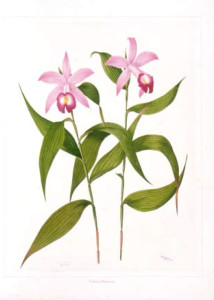
The books which form a typical family collection of bibles, classics, topography, history and architecture, date mainly from the Sixteenth to the Nineteenth Centuries and came from the library at Newbattle Abbey, formerly the Midlothian seat of the Marquises of Lothian, now an adult education college. (Most of these are now in the ownership of the National Library under terms of the will of the 11th Marquis). In addition, a particular treasure is the large set of water colours of orchids and fungi. These were painted in 1880 and 1892 by Miss Florence Woolward for Schomberg, the 9th Marquis, one of whose enthusiasms was the cultivation of orchids and of which he formed the largest private collection in the U.K. at Newbattle Abbey.
Over the west chimneypiece hangs a portrait of Robert, 1st Earl of Ancram by Hercules Sanders dated 1653. This shows the Earl as an old man in exile in Holland after the Civil War. Like many Scots nobles, he had accompanied James VI to London after the latter succeeded Elizabeth on the English throne. He was a prominent figure at court, serving as tutor both to Henry, Prince of Wales and to Prince Charles to whom he remained loyal till the end. He was also a poet and philosopher. His eldest son, William (whose portrait hangs in the dining room), unlike his father was a strong covenanter and supporter of Cromwell; he succeeded, through the female line, as 3rd Earl of Lothian while Robert's younger son succeeded as 2nd Earl of Ancram. Both titles were to come together in the Eighteenth Century, and Robert Ancram is the principal progenitor of the distinguished Anglo-Scottish family whose portraits are all here at Monteviot. Robert Earl of Ancram and William Earl of Lothian remained on good personal terms, despite being on opposing sides in the Civil War, and co-operating to arrange the Grand Tour of William's sons.

Over the east chimneypiece is a contemporary Chinese copy of the famous early portrait of John Donne, poet and Anglican clergyman, the original of which used to hang there but is now in the National Portrait Gallery in London. He was a friend of Robert, Earl of Ancram. The original picture was bequeathed to Lord Ancram by Donne, but only identified and 'rediscovered' in 1958. It is irreverently inscribed 'Illumine Tenebra Nostras Domina', and shows Donne painted in shadows and 'my black melancholy hat,' more as the author of the love poems than the Anglican Divine who became Dean of St. Paul's Cathedral in London. The artist was unknown.
On the east wall is a portrait of the wicked Countess of Somerset, daughter of Thomas Howard, 1st Earl of Suffolk. She divorced her first husband, the Earl of Essex, on the grounds that he was 'impotent with none but her,' and married the more handsome Robert Kerr, Earl of Somerset. She narrowly escaped being executed for the murder of Sir Thomas Overbury who had tried to dissuade Kerr from the marriage and was mysteriously poisoned. The Somersets were banished from Court, though spared the axe; James I remarked that being married to each other would be punishment enough.
The two little paintings of figures in architectural settings, which hang on the ends of the projecting bookcases, are characteristic works of Hendrick van Steenwick. They are dated 1676 (although invoices show that they were at least 15 years earlier) and show St Jerome in his study (with tame lion) and The Blind Isaac being deceived by his wife Rebecca.
From the windows are good views over the herb garden with its geometrical pattern of box-edged beds designed by the 9th Marquis, who was a keen gardener and talented amateur architect as well as one of the leading public figures of his day.
The River Wing
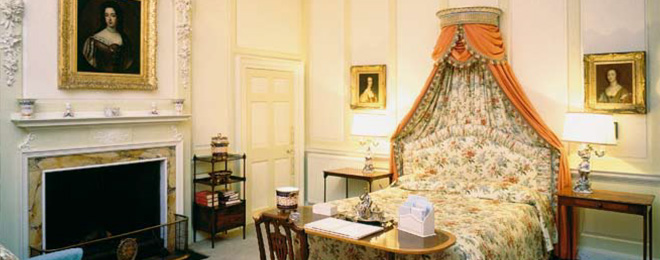
This is the western of the flanking Eighteenth Century wings and is the least altered part of the Georgian house. It now contains the principal guest bedroom suite.
The quadrant corridor leading from the library to the bedroom is hung with small Flemish and Dutch cabinet paintings characteristic of British Grand Tour collections, including a study of heads by Jordaens, also a pair of beautiful female nudes by G. F. Watts, who was patronized by the 8th Marquis.
The bedroom retains its original raised and fielded panelling, and carved Georgian chimneypiece. Architecturally, this is the finest room in the house. The panelling has recently been stippled a soft green colour. The canted bay contains a Venetian window from which there is a splendid prospect of the River Teviot and the 9th Marquis's brilliantly arranged plantations of mixed trees on the southern slopes beyond.
The Victorian family portraits include: chalk drawings of Lord Schomberg Kerr and William, Lord Jedburgh.
The Morning Room
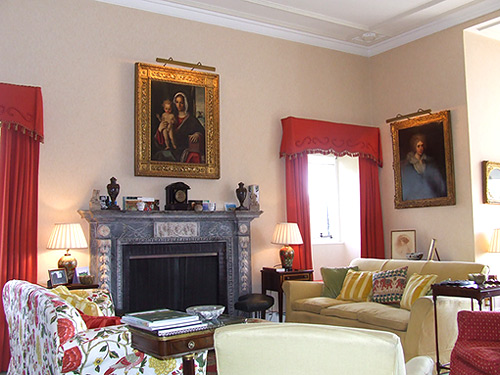
The Morning Room occupies the south end of Blore's wing, but was remodelled by Schomberg Scott. There is a handsome Georgian marble chimneypiece over which hangs an Italian Fifteenth Century Madonna and Child attributed to Bellini. Other paintings of interest in the room are two more of the Wootton classical landscapes in good Eighteenth Century frames, a pair of Scottish landscapes by Nasmyth, recently acquired, and two small Dutch landscapes by Ruysdael and Ostade, respectively. On either side of the big window are striking portraits by Sir Thomas Lawrence of John the 7th Marquis and his mother Henrietta, the 6th Marchioness. It was the 7th Marquis who commissioned Blore to rebuild this part of Monteviot. Before inheriting the title, he sat in the Commons as MP for Huntingdon in Lord Liverpool's government. He suffered from ill health and died aged only 47, which is why Blore's designs for Monteviot were not completed. Of his four sons, two, William and Schomberg, succeeded as 8th and 9th Marquises successively; the third, Ralph was the father of the 11th Marquis and the youngest, Walter, the grandfather of the 12th Marquis of Lothian.
Add Your Heading Text Here
The Dining Room
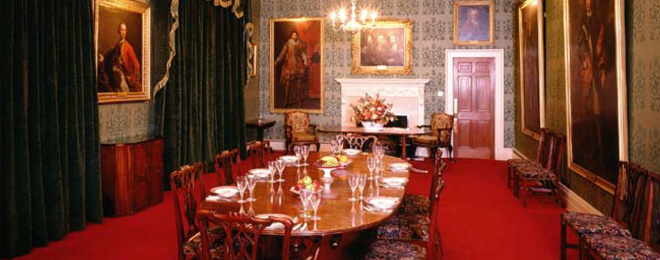
This occupies the ground floor of the Blore wing and was intended as the principal dining room of the house, a function it still fulfils. The attractive ribbed plaster ceiling has plaster stars, derived from the Kerr arms. The room was redecorated by Schomberg Scott who was responsible for the heraldic wallpaper which incorporates the Thistle for Scotland, the Rose for England and the fleur-de-lys for France. It commemorates James V of Scotland whose mother was English (Margaret Tudor) and wife French (Mary of Guise). This has recently been reprinted to the original design. The chandeliers were also designed by Schomberg Scott and complete his unified conception of the decoration.
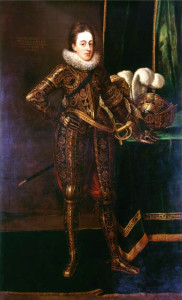
Much of the distinction of the room derives from the series of full-length, Seventeenth Century portraits in matching Eighteenth Century frames, originally at Newbattle Abbey. These include Charles Prince of Wales (the gilt armour he is wearing is now at Windsor Castle); the 2nd Marquis of Lothian, by Sir John Medina; William, 3rd Earl of Lothian 'the Covenanter', by David Scougall; and the Earl of Argyll, another covenanter, by Duchappell. Over the chimneypiece is a contemporary version of the Van Dyck triple portrait of Charles I. This was a gift of the King to his minister Lord Strafford (executed in the run-up to the Civil War). It formed part of the Hobart bequest inherited from Lady Londonderry (youngest daughter of the last Earl of Buckinghamshire) by the 7th Marquis. Between the windows is to be found a portrait attributed to Knapton of Lord Robert Kerr, younger son of the 3rd Marquis of Lothian who was killed at Culloden, and a portrait of Lord Newbattle (later 5th Marquis) dated 1762, by Robert Hunter. Over the sideboard at the east end of the room is an unusual equestrian portrait of the 4th Marquis of Lothian by David Morier (1751), which was for many years on loan to the British Embassy in Washington and has only recently been brought back to Monteviot. Over the doors are smaller portraits of the 3rd Marquis by Michael Dahl, and the 3rd Earl of Leicester, dated 1632 by Cornelius Johnson, and beside the door into the Great Hall another portrait of the military 4th Marquis, now attributed to Ramsay.
The Chapel

This occupies the site of the old Servant's Hall in the Blore wing and was remodelled to Schomberg Scott's design in 1962. The previous chapel was a detached building of no architectural merit to the northwest of the house and was demolished as part of the remodelling and rationalization of Monteviot in the 1960s. The new chapel is an excellently proportioned room with fine contemporary fittings. It is dedicated to the Border Saints.
The chapel is arranged college-wise and correctly orientated with the altar, under a tester or canopy, at the east end, and a carved wooden screen at the west inspired by that in the Sixteenth Century chapel at Falkland Palace, Fife. The excellent woodwork was all produced by the firm of Messrs. Anderson of Melrose.
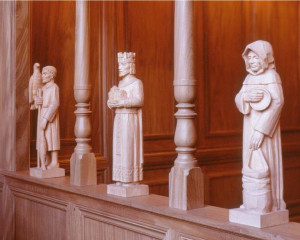
On the screen are six wooden statues of early Christian Borders Saints: King David of Scotland, Saint Waltheof, Saint Boisil, Saint Cuthbert of Lindisfarne, and Saint Drychthelme, as well as Duns Scotus, the philosopher, all carved by Norman Forrest of Edinburgh. The engraved glass in the large mullioned west window depicts a choir of angels with musical instruments and is the work of Ann Robertson of Haddington. The metal crucifix over the altar was commissioned from the Scottish sculptor, George Wylie. On either side of the altar are six fifteenth century Italian paintings of angels on a gold ground in the manner of Fra Angelico, which came from the previous chapel, and triptych of the central Italian school of circa 1400.
